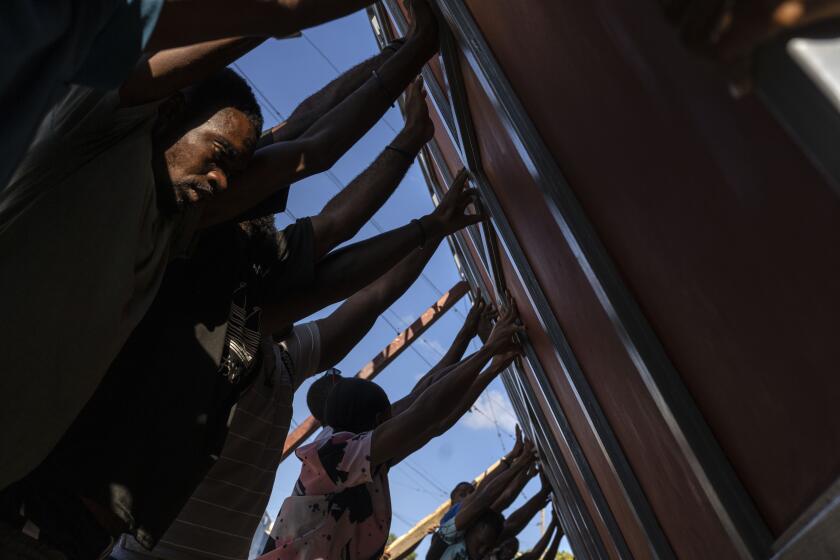Hunger in Haiti reaches famine levels as gang violence takes over the capital and beyond

- Share via
PORT-AU-PRINCE, Haiti — Nearly 6,000 people in Haiti are starving, with nearly half the country’s population of more than 11 million people experiencing crisis levels of hunger or worse as gang violence smothers life in the capital of Port-au-Prince and beyond, according to a report released Monday.
The number of Haitians facing crisis, emergency and famine levels of hunger increased by 1.2 million in the last year as gang violence disrupts the transportation of goods and prevents people from venturing out of their homes to buy food, according to the report by the Integrated Food Security Phase Classification.
In addition, 2 million Haitians are facing severe hunger, according to the report.
“This is shocking,” said Martine Villeneuve, Haiti director for the nonprofit Action Against Hunger. “We were not expecting that level. Two million … is massive.”
Villeneuve told the Associated Press that she also was surprised that some of the 2 million people hit by hunger don’t even live in places directly affected by gang violence.
Life in Port-au-Prince becomes a game of survival, pushing Haitians to new limits as they scramble to stay safe and alive while gangs overwhelm police.
While much of the hunger is directly tied to gang violence, double-digit inflation also has limited what many Haitians can afford to buy, with food now representing 70% of total household expenditures.
The cost of a food basket increased more than 11% in the last year, with inflation hitting 30% in July.
In addition, parts of Haiti are still struggling to recover from the August 2021 earthquake, various drought episodes, and Hurricane Matthew, which struck Haiti as a Category 4 storm in 2016.
Gang violence, however, accounts for most of the hunger, with gangs controlling 80% of Port-au-Prince and the roads that lead to and from northern and southern Haiti.
Despite the risks, thousands of young Haitians are jumping at the chance to become soldiers as widespread gang violence creates rare job opportunities.
From April to June, at least 1,379 people were reported killed or injured, and another 428 kidnapped. In addition, gang violence has left more than 700,000 people homeless in recent years.
“Haiti continues to face a worsening humanitarian crisis, with alarming rates of armed gang violence disrupting daily life, forcing more people to flee their homes and levels of acute food insecurity to rise,” the report stated.
Those experiencing famine live in makeshift shelters in the metropolitan area of Port-au-Prince, with 70% of people in shelters overall experiencing crisis levels of hunger or worse, the report found.
Among them is Joceline St-Louis, a 28-year-old mother of two boys, 5 and 1.
“Food doesn’t come around very often,” she said, adding that she depends on others to feed her children.
Guatemalan President Bernardo Arévalo says his country will send 150 military police officers to help Haiti fight violent gangs.
“When an organization does provide food, there’s a major fight,” she said.
St-Louis said she has to take her 1-year-old to a clinic so he can receive a peanut butter mix “so that his body doesn’t collapse in my arms.”
“I’m sometimes so depressed that I sometimes want to kill the kids and myself,” she said in a soft voice as she cradled the 1-year-old in her arms while the 5-year-old played with his friends.
In another shelter nearby, Judeline Auguste, 39, said she depends solely on remittances to feed herself and her 8-year-old boy, but the money barely lasts a week.
“It’s very rare that I can get a meal a day,” she said. “My situation is hard not because of me, but because of my son. He looks at other people eating all the time, and he starts crying, ‘Mommy, I’m hungry.’”
Despite the risks, thousands of young Haitians are jumping at the chance to become soldiers as widespread gang violence creates rare job opportunities.
Meanwhile, those facing urgent levels of hunger live in Haiti’s northern, central and southern regions, as well as in the capital.
Jean Yonel, who fled his home with his family after gangs raided their neighborhood, said there are days that he, his wife and their seven children eat only white rice or spaghetti.
“I can’t provide every day for these children,” Yonel said. “Sometimes we take just a spoonful of food and leave the rest of the food for the kids so they don’t die.”
Yonel used to work as a mason, but with construction jobs drying up, he is now forced to search for wood to make charcoal. His wife sells second-hand clothes.
On days when they can’t afford a proper meal for their children, she mixes flour with spinach to keep their stomachs from rumbling.
Sanon and Coto write for the Associated Press.
More to Read
Sign up for Essential California
The most important California stories and recommendations in your inbox every morning.
You may occasionally receive promotional content from the Los Angeles Times.













